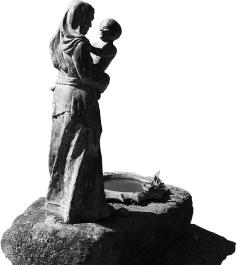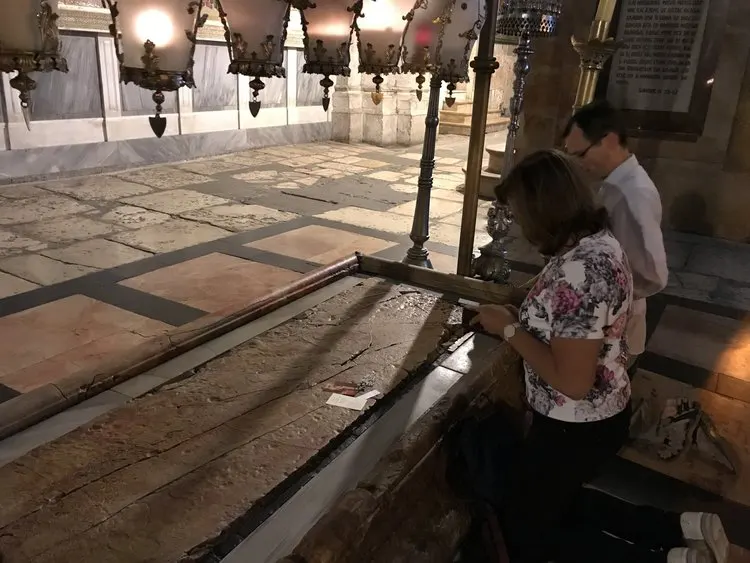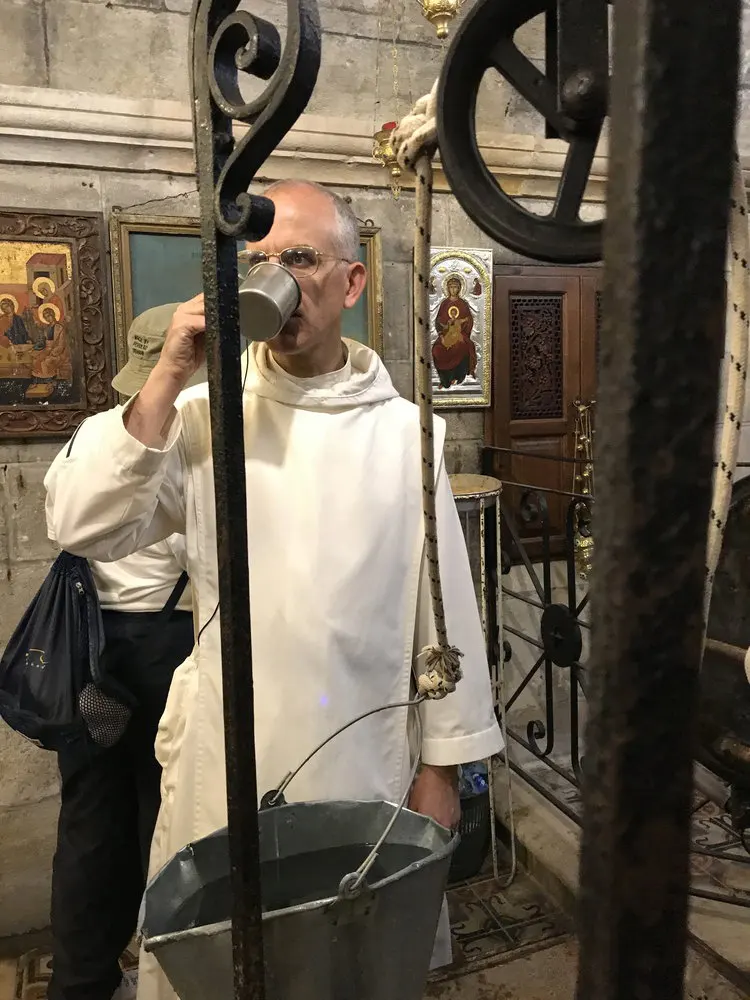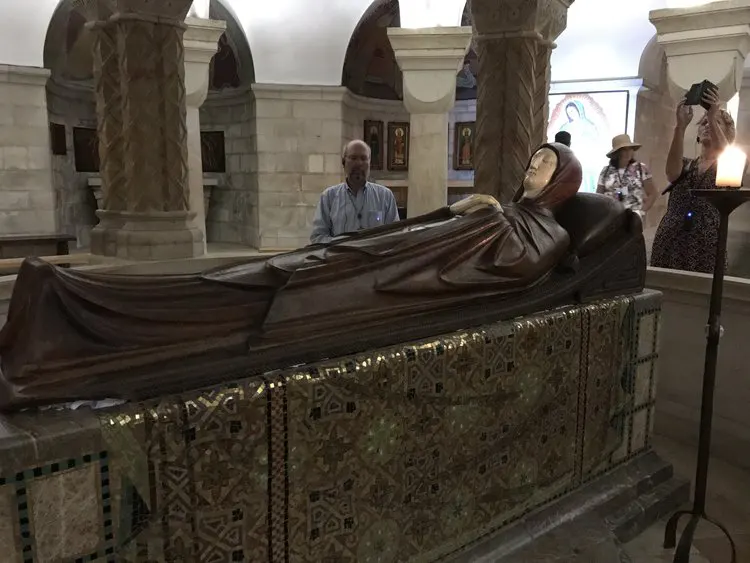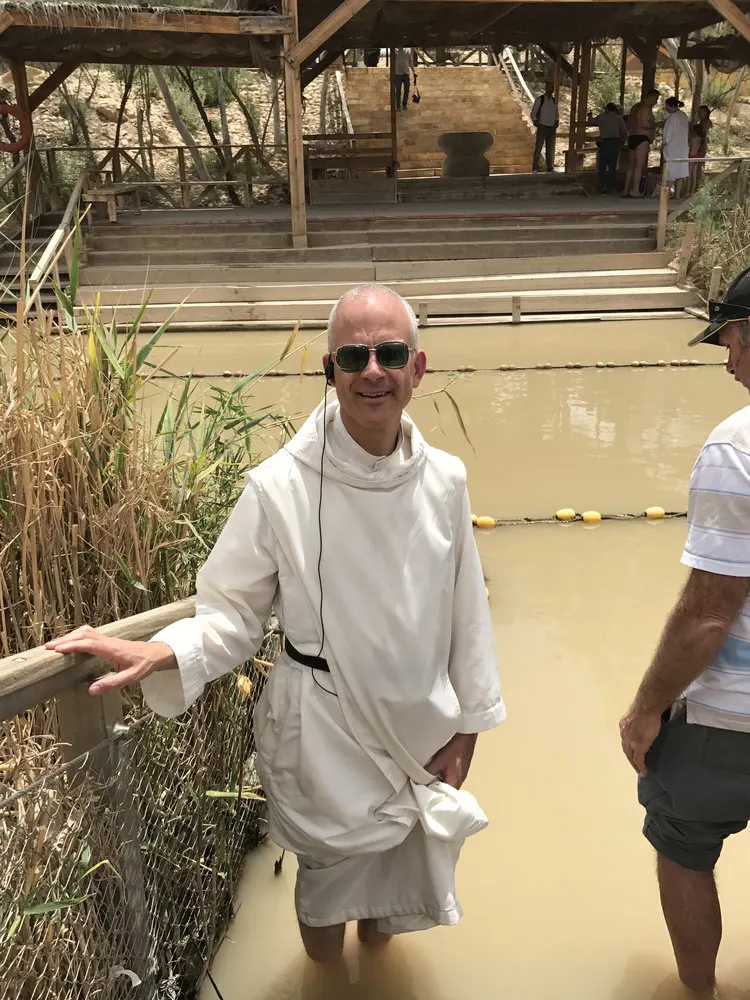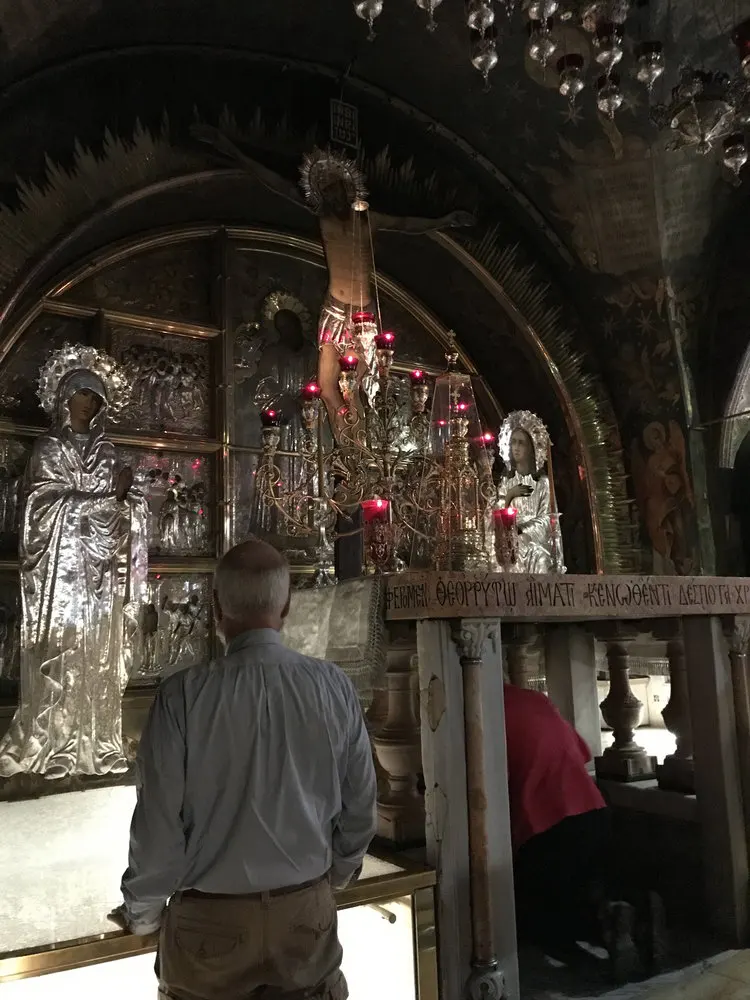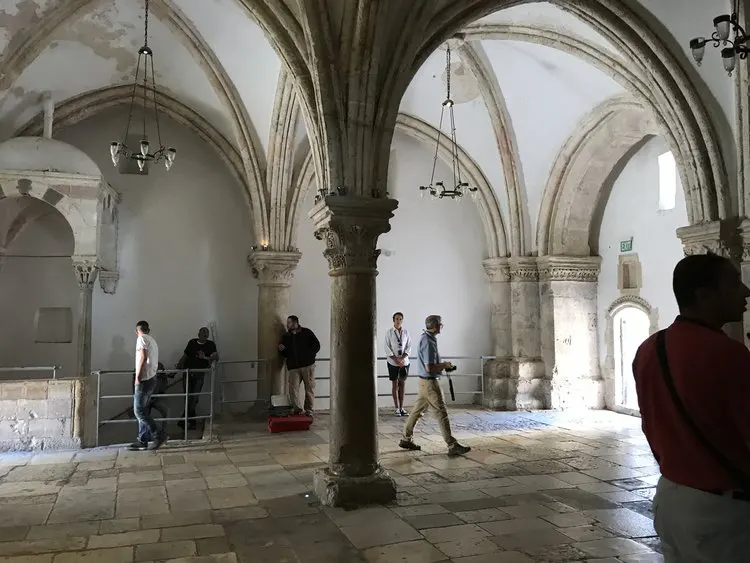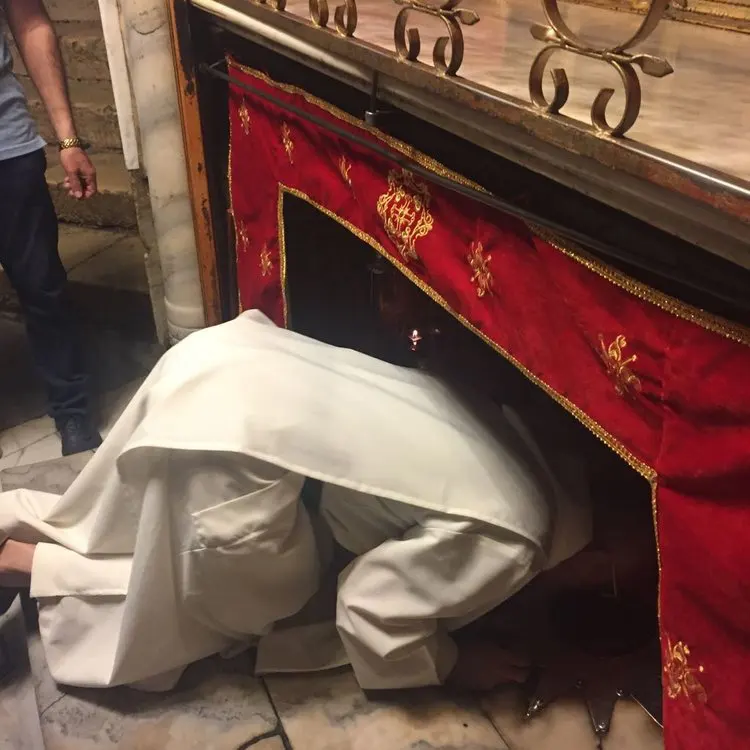25 April, 2017
St Mark
Greetings from Jerusalem!
I arrived, safe and sound, but quite a bit exhausted after about 38 hours of travel. Upon arrival at Christmas Hotel in Jerusalem, I went in search of a place to offer Holy Mass. Fr John had suggested going to the Holy Sepulchre. But on the way up the Via Dolorosa, I approached a Franciscan who was following us. and asked about offering Mass. He graciously said I could do so at his convent, which is at the Lithostrotos, where Pilate condemned Our Lord to death. But before that, he gave us a tour of the Holy Sepulchre and all it includes, with Calvary. So it was a delightful addition our pilgrimage even before it starts.
It really doesn’t start till today when the group from the US arrives.
Some initial thoughts: the city is stamped with the signs of division. It hurts to walk through the Old City and hear the sad Muslim prayers being imposed on everyone through the loud speakers. No use in asking people for directions: unless they are Christian and speak English, you probably won’t get an answer, and you might even be insulted… (the Franciscan said “be prepared to get spit in the face; it happens”)
I also mused that when Holy Scripture says that God chose Israel because it is the smallest and weakest of all nations, you see how true that is when you are here. God did not choose one of the most powerful nations such as Egypt, China, Babylon, Greece or Rome. He chose the Jews, a nomad race, with profound intellectual acuity for sure, but without much to offer in terms of human grandeur. A great consolation to us: God continues to choose the poor, the weak, those who don’t count. He is disgusted with those who thing they are great, or who take His justice in their hands, or who think they can impose themselves by force on others. Nothing could be further from the reality.
Another consideration: reciting the psalms here is fascinating! All the references to Israel and Jerusalem take on renewed significance. If only Israel would acknowledge its Redeemer and Saviour, then true peace would come to this people!
26 April, 2017
This evening I write to you from Stella Maris Carmelite Monastery in Haifa in the northern part of Israel on the Mediterranean Sea. Haifa is the third largest city of Israel, after Tel Aviv and Jerusalem. More importantly it is built over the cave where the Prophet Elijah took refuge when persecuted by King Ahab and his wicked wife Jezabel.
This morning, after the arrival of the other pilgrims (we are 15 in all, with 7 Australians, myself included) we first drove up the coast to Mount Carmel where Elijah put to the sword the 450 prophets of Baal after they were unable to get their sacrifice accepted by their false gods who were really demons (see 3 Kings 18).
Holy Mass was offered this evening here at Stella Maris. Given the circumstances I offered a votive Mass of Our Lady of Mount Carmel and pointed out one of the ways in which Our Lady resembles Elijah, namely her humble receptiveness to God’s message. Whereas false religions always take their origin in human pride which refuses to humble itself before God and tries to take things into its own hands, and ends up creating its own lifeless and cruel gods, the true adorers of God place all their trust in Him and wait for His day, accepting not to be in control of events, but abandoning themselves to God.
The Mountain of Carmel overlooks the Valley of Jezrael, also known as the Valley of Armageddon where the ultimate battle between Christ and anti-christ is to take place.
Tomorrow we’re off to Galilee where we will spend three days.
27 April 2017
St Peter Canisius
Today was an eventful day. We left early and drove first of all to the Mount of the Transfiguration, that is, Mount Tabor. The final part of the ascent we had to leave the bus and take a taxi. Four of us walked it, for about 35 mn: a steep ascent which took us to a fantastic view overlooking the Valley of Jezrael from the other side.
We then drove to Nazareth where we were able to spend a good amount of time in the Basilica of the Annunciation, where under an altar at the very spot of the Incarnation, a plaque says: “Et Verbum HIC caro factum est”. It was, as you might imagine, a powerful moment. As was the Holy Mass shortly thereafter in the nearby church of St Joseph built over St Joseph’s workshop
Our third stop today was for….. CANA! We only spent about an hour there. The first 15 mn were spent presiding over the renewal of marriage vows of the three couples who were there. After that, I got a few photos in front of significant objects and a few souvenirs from Cana which I will share with you upon my return…
Final we drove to the Mount of the Beatitudes where we have accommodations for three days, while visiting the important sites around Galilee.
28 April 2017
St Louis de Montfort
This morning our day began with a 6:30 Mass on the Mount of Beatitudes overlooking the Sea of Galilee. I chose a votive Mass in honour of All Saints, as that Mass contains the Gospel of the Beatitudes — once again an intense moment to read and preach on this foundational text of our faith on the very spot where it was first pronounced.
After Mass we drove to Chorazin, one of the towns Our Lord cursed, and which is now in ruins — a salutary reminder of the need not to neglect the graces of God.
We then visited a couple sites which are move relevant to Jewish history since the coming of our Lord, in particular the town of Safad and Mount Meron, in northern Israel very near the Syrian border. One could see Mount Hermon, the highest summit in Israel, and referred to in Psalm 88 “Thabor et Hermon in nomine tuo exultabunt”. We also visited two synagogues, my first time ever in one! It was quite interesting to see the Holy Place where the scrolls of the Law are kept and venerated with an ever-burning lamp, the prelude of our Catholic tabernacles where we no longer have just holy writings of the word of God, but the Word Himself incarnate. The second synagogue contains the tomb of a well-known rabbi by the name of Rashbi from the 2nd century AD and who is venerated (by Jews) as a saint. We men actually couldn’t enter there because when we arrived there was a large group of rabbis, some of whom who looked at me with suspicion — Christians are not always welcome in these places of staunch jewish observance. The women however on the other side were able to go, but they did not stay long, finding it very uncomfortable. Roy Schoeman took the opportunity to remind us to pray for the conversion of these souls who are still in the dark, with a veil over their eyes, and yet clearly full of zeal for the law and the prophets, and going to great pains to maintain the traditions they believe in.
Of greater interest was the visit to Cesarea Philippi, where St Peter confessed the faith of the Church for the first time, in Matt 16. I read the passage over and commented it, along with the triple act of love after the resurrection and the Lord’s prayer for Peter at the last supper, all clear signs of the very special role he plays in our faith.
Our final special moment today was a boat outing on the sea of Galilee. The weather was superb. We all agreed this was really a memorable experience. At sea we read the passages of the multiplication of loaves, the place of which we could see, and then the walking on the waters and the calming of the storm at sea, all of which I commented on, hopefully giving the pilgrims a bit more insight into these events of our sacred history and their significance in our daily lives.
29 April 2017
Holy Abbots of Cluny
Whew! Another intense day!
For starters, we visited Tabgha, the site where Jesus multiplied the loaves and fishes. There is a church and an altar built over the very stone where Jesus placed the bread and fish before multiplying them. We had a good amount of silent prayer here, and I could hear the Lord saying to me, “You yourself give them to eat”, and I asked for the grace to always have the words of grace for all those who come to me, and the strength and fortitude to serve the needs of all my sons and daughters in the Lord.
Then we went to the nearby site of the Primacy of Peter. This is the spot where the apostles hauled the second miraculous catch of fish ashore and were served breakfast by Our Lord, who then asked Peter for the triple act of love, in exchange for which he confirmed him in the primacy over the whole church. This is where we offered holy Mass, once again overlooking the Sea of Galilee. The church behind the altar is where the “Mensa Christi” is, the spot where the Lord prepared breakfast for His apostles.
After some time bathing our feet in the Sea of Galilee, we drove to Capernaum, where we spent time in the ruins of the synagogue. I never thought I would find myself preaching in a synagogue, but there I was! My preaching was quite simply the reading of the discourse on the Bread of Life in John 6 which took place there, and then offering a few reflections on it. Roy Schoeman gave some very welcome comments on the importance of the fact that this discourse took place around the Passover and all that means in terms of the Eucharist fulfilling the ancient Jewish rites. His insights are very helpful because of his vast knowledge of the Hebrew scriptures and traditions.
Our fourth stop this morning was at Magdala, the home town of St Mary Magdalene. This is a recently excavated site, on which there are the ruins of a first century synagogue. The land was purchased by the Legionaries of Christ who actually discovered the ruins, and they are building there an immense complex for welcoming pilgrims. There is a fascinating painting of the woman with the hemorrhage touching Our Lord by the tassel of His garment. The chapel is meant to evoke Jesus’ ministry around the Sea of Galilee and the altar is in the shape of a boat…
We then had lunch during which we were served “St Peter’s fish”, supposedly the same kind of which St Peter found the piece of silver for the temple tax as found in the Gospel.
Then in the afternoon, our final stop today was at Kursi, which is better known to us as the land of the Gerasenes, where in Mark 5 Our Lord cast out the demons from a possessed man who lived naked in the graveyards. It was the opportunity to remind people of the demonic and of the ways of protecting ourselves from evil. Chesterton’s comments on the significance of the delivered man being found “clothed and in his right mind” afforded me the opportunity to insist upon modesty in dress, the lack of which is always the sign of the corruption and degradation of the human mind and soul.
Finally upon our return to home base, I was able to visit the basilica which is at the top of the Mount of Beatitudes where we are staying. As it is only open a few hours a day, we missed it the other days. But this afternoon, I was able to spend a good amount of time there, reciting Vespers, the 9 Memorares, the Litany of Our Lady and that of St Joseph, as well as our ritual prayers at the end of Mass.
Tomorrow we head down to Jerusalem where we will stay till the end of the pilgrimage, but on the way, many things to see. All about that tomorrow!
Blessings of Good Shepherd Sunday to each and all. Ask the Lord to make me a Good Shepherd, and for the grace to lay down my life for my sheep…
30 April 2017
Good Shepherd Sunday
Laetatus sum in his quae dicta sunt mihi: in domum Domini ibimus!
Greetings from the Holy City where we have just arrived after another intense day of pilgrimage.
We left the Sea of Galilee, not without a bit of sadness: such a special area where the geographic beauty unites with all the episodes from the Lord’s life.
Our first stop, after about 2 hours, was Nablus, which is in Samaria, and which is the spot where Jacob’s Well is venerated. We read John 4, the episode with the Samaritan woman, and then went to the well. The stone structure of this very deep well is over 2000 years old, so it is certain that it is the very one Our Lord sat at. We were able to draw and drink water from it, and then prayed for a while in silence. An orthodox priest there gave me a beautiful postcard icon of Jesus with the Samaritan woman, who went on to become a saint, St Photini.
After Nablus, we got back on the highway which follows the Jordan valley and arrived at the spot where Our Lord was baptized. There were many people and lots of people coming to be baptized (a lot of them Protestants, I believe). We ran into an American bishop from Texas (I myself only saw him from a distance). Next stop was at the Mount of Temptation, which is set in the Judean desert, truly a lifeless wilderness (it makes Tasmania look like a luxuriant tropical resort!)
This trip south took us through what is known as the West Bank much of which is under Palestinian control. My personal impression was one of great poverty and dirtiness. In some of the Palestinian towns we drove through, there was rubbish everywhere, and nobody seemed to care. There were also Bedouins encamping at various places along the road.
Our next and final stop for today was Bethany. We first visited the Tomb of Lazarus, then had Mass in a beautiful church nearby built on the spot of the house of Martha, Mary and Lazarus. I there reminded the pilgrims of the importance of hospitality, as Martha, Mary and Lazarus gave to Our Lord, and also of listening to the Word of God, which is the better part chosen by Mary.
That’s it for today. The rest of the pilgrimage is around Jerusalem. Tomorrow we’re off to Bethlehem.
1 May 2017
It keeps getting better! Today our first stop was at the Field of the Shepherds where we visited the spot of the apparition of the angels and the first “Gloria in Excelsis Deo”. Mass was offered here and the feast of St Joseph afforded me some reflexions on St Joseph’s role on the first Christmas night.
We then went to the Milk Grotto where Our Lady is said to have nursed the baby Jesus and where a drop of her milk touched the ground, turning the stone white. It is a very touching spot. You can get in this place some powder which I believe is ground up from part of the stone, and is said to have the virtue of helping overcome infertility. Several of the pilgrims got some to take back for people they know.
We then moved on to the site of the Nativity. Here we got a taste of what the Holy Family went through on the night of the first Christmas: the crowd was enormous and the queue took forever to get to the tiny grotto and venerate the very spot of the Nativity. But it was worth it entirely. To be there in the very spot where Jesus was born for our salvation was an ample reward for a couple hours patience in the crowd.
After lunch, we went to Ein Karem where St John the Baptist was born and where the Benedictus was first sung by Zechariah. Then we went to the site of the Visitation where the Magnificat rang out for the first time. I told the pilgrims of Fr Faber’s remark that the Mary’s journey to visit Elizabeth was the first ever Eucharistic procession!
Finally, we paid a visit to the tomb of Alphonse Ratisbonne, who as you may know, was the 19th century Jew converted by the Miraculous Medal and the Memorare and who founded an order to pray for the conversion of the Jews. Peter Hill here told the moving story of his daughter Clare’s accident and miraculous cure due to the Miraculous Medal.
It’s all a bit overwhelming, so much to take in. My heart is full of gratitude for this opportunity which I ask will overflow onto each of you and onto the priory and its future.
Tomorrow I will have the privilege which few pilgrim priests get apparently, of offering Mass in the Holy Sepulchre, the very stone on which our Lord was laid and resurrected. Will bring each one of you and your intentions to this unique altar.
2 May 2017
St Athanasius
Dearest Brethren,
Today must have been the top. It started with a 5 AM departure from the hotel, at least for those who were game. 8 out of 15 pilgrims were. We walked down to the old city, through the Damascus Gate, then up to the Holy Sepulchre.
For those of you who have never been here or read about it, by “Holy Sepulchre”, we actually mean Calvary and the Holy Sepulchre, for an immense basilica covers the entire area, which is not very big to tell the truth, since, according to the Gospel, the tomb was nearby Calvary.
We got there around 5:20 and went up immediately to the site of the Crucifixion, where it was still fairly calm (during the day, it’s worse than Bethlehem!) Quite moving however to see the hordes of people thronging to visit from all over the world — I even saw some Muslims going into the Holy Sepulchre… We spent about an hour in silent prayer there, and each of us were able to kiss the very spot where the cross was erected. We could hear the Armenian monks singing Lauds at the Holy Sepulchre: quite impressive—but a far cry from the beauty of our Gregorian chant!
Around 6, the Masses start, and as there was a German Mass at the Latin altar next to Calvary, I went down and continued Matins and Lauds before the Holy Sepulchre.
Our time for Mass was 7 AM, and our guide had given us precise instructions on how to proceed. The Holy Sepulchre itself is like a small chapel composed of two main parts: a vestibule big enough for about 20 people, and then a very small space for the altar over the very place where Our Lord’s sacred body was laid. In this part there is room for the priest, the server and one or two others squeezing in. The plan is for the people in the vestibule to relay each other so that all can be at the tomb for a minute or so during the Mass. We had only 25 mn, no preaching and no singing. It was truly moving, and we were all quite overwhelmed as we came out. Before Mass, I had a bit of hesitation about which Mass to say (a votive Mass of the Passion, the Holy Cross, the Resurrection…), but the epistle of the Mass of the day (St Athanasius) was so appropriate for the occasion that it providentially carried the day: “We preach not ourselves, but Jesus Christ our Lord: and ourselves your servants through Jesus. For God, who commanded the light to shine out of darkness, hath shined in our hearts, to give the light of the knowledge of the glory of God, in the face of Christ Jesus. But we have this treasure in earthen vessels, that the excellency may be of the power of God and not of us. In all things we suffer tribulation: but are not distressed. We are straitened: but are not destitute. We suffer persecution: but are not forsaken. We are cast down: but we perish not. Always bearing about in our body the mortification of Jesus, that the life also of Jesus may be made manifest in our bodies. For we who live are always delivered unto death for Jesus’ sake: that the life also of Jesus may be made manifest in our mortal flesh. So then death worketh in us: but life in you. But having the same spirit of faith, as it is written: I believed, for which cause I have spoken; we also believe. For which cause we speak also: Knowing that he who raised up Jesus will raise us up also with Jesus and place us with you.” (2 Cor 4:6-14)
Interestingly also, as I was waiting in the sacristy before Mass, one of the Franciscans approached me and gave me a traditional altar missal and altar charts! It makes you feel like you are in friendly territory.
After Mass, reluctantly we had to come back down to earth and return to the hotel for some breakfast before returning to the Old City. This time we began by visiting the pool of Bethesda or Bethsaida, where the paralytic in John 5 was cured. I should say the remains of the pool, for it is no longer a pool. A pleasant surprise was that just next to it is a beautiful church on the spot where…. Our Lady was born! So we here sang a Regina Coeli and Ave Maria.
Then we made our way to the site of the Scourging and the condemnation of Our Lord (the Lithostrotos), where we started the Via Dolorosa through the streets of Jerusalem. A very unique experience. Surrounded by other groups doing the same thing, but also merchants trying to sell their things, deliveries of various items for which we had to make way, the noise, the indifference of many, the hostility of others (my sister Martha, when it was her turn to carry the cross, was splashed with filthy waste coming out of a window…) gave us all a sense that when Jesus first went that way, it must have been similar, but only much more hostile. I could not help but reflect that today as yesterday, Our Lord accomplishes His saving work, in spite of the noise and indifference and hatred. His grace reaches us today as it did yesterday through daily fidelity in carrying our cross in spite of contradictions and bruises.
We finally reached Calvary and the Holy Sepulchre again, but terribly noisy compared with the calm morning prayerful atmosphere. Thank God for the “whispering devices” you may have noticed in some of the photos: it allows the guide or priest to make himself heard even in the noisiest spots, and even if we get separated, as everyone has a speaker in his ear.
After our way of the cross and the visit to the other chapels, including that of the “Inventio” (or Finding of the Holy Cross by St Helena) whose feast we celebrate today, we had one final stop at what is known as the Western Wall or the Wailing Wall, where Jews go and pray.
Then about 1:30 we made our way back to the hotel, for a free afternoon. I then went with Roy Schoeman to the nearby site of St Stephen’s stoning, where there is a magnificent basilica built about a century ago with lots of side altars for private Masses, unfortunately abandoned today. This church is held by the Dominicans who also man the Ecole Biblique of Jerusalem which is adjacent to the basilica. We approached and a very kind old Dominican (you had to guess it though…) showed us around the incredible library begun in the 19th century and continually kept up to date with just about everything written in the realm of Biblical studies… The famous Father Marie Joseph Lagrangeis buried in the sanctuary of the basilica.
3 May 2017
Finding of the Holy Cross
Another memorable day. First of all, I went early with two other companions to the church of the Holy Sepulchre, where we once again venerated Calvary and prayed in silence for about 45 mn before going down to make our devotions at the Holy Sepulchre while the Armenian monks prayed their office, and finally spending some time at the “Inventio” on this feast.
After returning to the hotel for breakfast, we took the bus for a very important stop: the Cenacle! Unfortunately this site is property of the Israeli government, so, unless you are the Pope, you can’t say Mass there. All the same, it was touching to read there the accounts of the Last Supper and that of another all-important event that took place there, namely the descent of the Holy Spirit and the beginning of the Church.
We then paid a brief visit to the (supposed) tomb of King David. We then had Mass in a small chapel held by the Franciscans, as close to the cenacle as you can get. It is modern and an architectural horror, but in my homily I reminded the pilgrims that, whatever the decorum, the Holy Mass gives us the entire spiritual good of the Church. I offered a votive Mass of the Holy Eucharist, reserving today’s Mass for Saturday when we hope to have an altar at the Finding.
I also pointed out that the Cenacle was the scene of the institution of the priesthood and that, when he said to the apostles: “Do this in commemoration of Me”, he thought of each of the priests who, till the end of time, would take part in His eternal priesthood.
After Mass we went to the nearby church of the Dormition of Our Lady, a beautiful edifice where we sang the Regina Coeli and the Ave Maria before going down to the crypt which contains a statue of Our Lady lying in sleep, adorned above with emblems of the holy women of the Old Testament. We there recited three decades of the Rosary and sang the Salve Regina.
Our next stop was St Peter in Galli Cantu, which was in the first century the house of the High priest where our Lord was judged, denied by Peter (whence the name) and spent the night in a dark prison. This spot was moving, especially the deep pit where we read psalm 87, and then the outdoor stairway which leads down to the Kedron Valley, and is therefore the very same stairs Our Lord was dragged up and down.
Our final stop today was an excursion to the Dead Sea. This of course is not a pilgrimage, but was a welcome addition to the itinerary, allowing us to deepen our knowledge of the land. Several pilgrims went for a dip in the sea. I refrained, even though it might have been a good opportunity to learn how to swim — you can’t sink!
4 May 2017
Dear Brethren,
Today once again I went off early with a few other pilgrims to the Holy Sepulchre where I spent my meditation time at the foot of Calvary, but this time in front of the Lady Altar commemorating the Taking down from the Cross. I then said Matins and Lauds down near the Holy Sepulchre, assisting at the end of the Armenian monks’ lauds — quite impressive.
After going back to the hotel for a bit of breakfast, we were off to the Garden of Olives where we had an outdoor Mass, not far from the actual spot where Our Lord suffered His agony. It was noisy, very noisy, as this is now a busy part of the city: there were cars, and horns, and police sirens, and lots of distractions to compete with especially during the homily, but after that it was better especially during the Canon. I spoke of the necessity of prayer and of the reasons for Our Lord’s agony, which were mainly his foresight of all the sins that would be committed. I pointed out that God makes His way through the distractions and noise of the world: even if we are distracted, He is not.
After Mass we visited the rest of the Garden, including some very old olive trees, one of which in particular is thought by experts to be 2000 years old, and which would therefore have witnessed the agony. We then had some silent time in the church.
Our next stop was for the Mount of the Ascension which is none other than the Mount of Olives. There is only a small edifice on the top with a mosque, but eastern rite Christians can use the outside altars only on the feast of the Ascension. The Latin rite uses the church of the Pater Noster, our next stop just next door. Here there is a cave where our Lord taught the Pater to the apostles. Providentially, we met there a group of Christians originally from Antioch, and who said the Pater for us in Aramaic, the language Our Lord used to pray it for the first time. That was very special, then we ourselves recited it together in English. There is a Carmel attached to this site, with nuns praying for the intentions of pilgrims.
Next stop down the hill was the Dominus flevit, where the Lord wept over Jerusalem. From here there is a fantastic view over Jerusalem and the guide showed us from there the various scenes of the passion of Our Lord: truly fascinating: my only regret was that I did not film it! The Dominus flevit reminds us of the need to be attentive to the Lord’s visits and not to let them go by without receiving them and allowing them to bear fruit.
From there we went back down to the church of the Agony, the reason being that it is hard to get access to the Rock of Agony unless you are there at the precise end of a Mass when all pilgrims can approach and touch the rock that received Our Lord’s sweat and blood. This was another intense moment for all the pilgrims.
Finally we made our way back to the hotel where once again we have a free afternoon.
5 May 2017
St Pius V
Our last official day of pilgrimage saw us return — after the accustomed early morning prayer —to St Peter in Galli Cantu, for this is where we had Mass booked. There is a beautiful church there, and this must have been one of our most silent Masses as there was no competition. This church contains three mosaics: on the left side, the denial of Peter (without a halo), standing over the coals and warming himself. In the middle, St Peter going out to weep bitter tears, having recovered his halo. And on the right, the Lord asking him three times, “Do you love me more than these”, sitting on the shore of the Sea of Galilee before hot coals…. I offered the Mass of the Passion, and insisted upon the necessity of self-denial in order to follow Christ and also on the grace of tears which St Peter got, and which is one of the most intense spiritual consolations one can have. After Mass, we were once again free to wander around and pray. After some thanksgiving in the church, I went back down to the deep pit, then up to the sacred stairs down which Our Lord was dragged. A few of the pilgrims were inspired here to received the sacrament of Penance.
After this Mass, we bade farewell to two of the pilgrims who are heading off to Egypt for a couple weeks. As it is impossible to find public transportation from Israel on the sabbath, they had to go today.
So, they were not with us for the last stop. This was not in the strict sense a pilgrimage, but rather a homage to victims of the Holocaust, at Yad Vashem museum. This visit was hard, I think, for all of us. The Israeli government has done a good job of showing in photos and videos and artifacts of the time the rise to power of Hitler, World War II, and the extermination of the Jews. There is a lot to see, and it is not pleasant. As I walked through it, and then prayed my Rosary, I couldn’t but think that there is one thing missing: a crucifix. No Jew ever suffered more than Jesus did. I could only pray that somehow, the victims of this horrible, satanic, endeavour to kill and destroy, were united with the passion of Christ whom they did not know, but in whose steps they followed in spite of themselves. Let us pray that they may have met Jesus in the end, and turned to Him, the only Saviour. On the way back, in the bus, we prayed the Rosary for all the victims, the perpetrators, and for the conversion of the Jews, so that the veil may be lifted, and they may find peace in their Saviour whose love for His own people is not diminished.
6 May 2017
This was our last morning in Jerusalem, and we had booked the altar of the Finding of the Cross, deep down under calvary, at 6:30. I had a pleasant surprise when I got there, for I had been several times to this spot. But this morning the walls behind and around the altar were draped with beautiful golden fabric adorned with Christian symbols, and the altar, usually bare as it is not used very often, was now covered with a beautiful altar cloth. Another surprise awaited me in the sacristy. The good Franciscan who had been so kind the other day, this morning had already prepared the missal and altar charts. AND, he had put out an extraordinarily beautiful Roman vestment, complete with maniple, chalice veil and burse. This Mass was special, as it was the last. I celebrated the Mass of the Finding (3 May) pointed out how the cross has been following us around throughout the pilgrimage, inviting us to offer our sufferings with those of Jesus, “filling up in our flesh the sufferings that are wanting to the passion of Christ” (Col 1:24). At the end, our Northern Irish pilgrim Philip Killen, sang for us St Patrick’s Breastplate, which was a fitting conclusion to the entire pilgrimage.
We then walked back to the hotel for breakfast, after which we bid each other farewell, sang the Regina Coeli one last time, I gave a final blessing, and most left for the airport.

